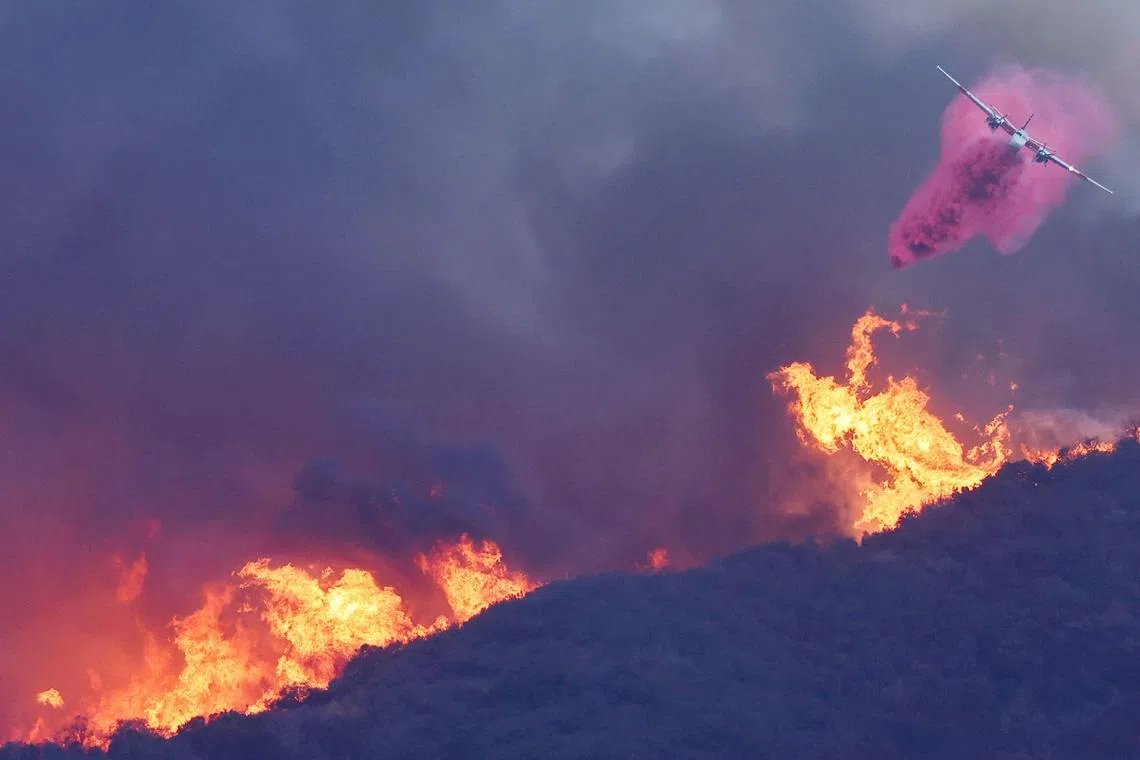Powerful Santa Ana winds expected to elevate fire risk in Southern California
Sign up now: Get ST's newsletters delivered to your inbox

There is a chance the winds could be similar in strength to the fierce gusts that fuelled wildfires in Altadena and Pacific Palisades.
PHOTO: AFP
Amy Graff
Follow topic:
Strong, damaging Santa Ana winds are expected to bring extreme wildfire danger to Southern California from Jan 20 into Jan 21 as the landscape remains starved of rain, and as firefighters continue to work to fully contain wildfires.
The disaster has left at least 27 people dead and destroyed thousands of homes in January.
Although an offshore wind pattern is expected across Los Angeles and Ventura counties from Jan 20 through Jan 24, the winds are predicted to pose the highest danger on the night of Jan 20 into the morning of Jan 21.
There is a chance the winds could be similar in strength to the fierce gusts that fuelled the devastating wildfires in Altadena and Pacific Palisades.
The big difference with these winds, though, is that they are expected to affect different locations. They will blow with a more north-east-to-east tilt than the Jan 7 event, which had a north-to-north-east tilt, said Ms Rose Schoenfeld, a meteorologist with the National Weather Service office in Oxnard, California.
The areas likely to see the strongest gusts include the San Fernando and Santa Clarita valleys, the mountains and foothills of Los Angeles County and much of Ventura County.
Amid the windy conditions, downed trees, power outages and dangerous ocean conditions are likely.
The persistent offshore pattern will suck any remaining moisture out of the vegetation, which is already dangerously dry because rain in south-western California has been “historically scarce”, the weather service said.
Relative humidity levels are poised to plummet, especially on Jan 21, and will reach single digits in some cases. The winds, along with dry fuels and bone-dry air, “would yield locally rapid fire growth with any new fires”, Ms Schoenfeld noted.
Southern California is primed to burn. Big storms soaked the landscape during the previous two winters, allowing vegetation to thrive. But since spring, the region has had scant rainfall, with grasses and brush withered and flammable.
The weather gauge in downtown Los Angeles, a good indicator of rainfall for the county, has recorded only 0.73cm of rain since May 1.
This would put it on track to be the lowest amount of rain ever measured between May and January, with records going back to 1877.
At least 5.1cm of rain is needed to significantly lower fire risk, according to Mr Brian Newman, who analyses wildfire behaviour for Cal Fire. Of the expected weather conditions in the upcoming week, he added: “Hopefully, we get no new ignitions, no new fire starts – at all.”
Santa Ana winds are those desiccating ones that occur commonly in winter, blowing out of Nevada and Utah and into south-western California. Carrying dry desert air, they push over the mountains in the Transverse Ranges and accelerate as they move downslope, howling into the canyons and valleys.
The winds are expected to mainly affect northern and western portions of Los Angeles County and a majority of Ventura County.
On Jan 21, warm weather with afternoon temperatures in the high 60s to low 70s, as well as low relative-humidity levels in the teens and single digits, will add to the high fire risk.
Winds are expected to be calmer on Jan 22, but could pick back up on the night of Jan 23 and into Jan 24, before probably relaxing again in the afternoon of Jan 24.
The weather service alerts the community of dire fire conditions through red-flag warnings. It has issued one from 10am on Jan 20 to 10pm on Jan 21 for portions of Los Angeles County and much of Ventura County.
A less severe fire weather watch was issued from 10pm on Jan 21 through 10pm on Jan 23.
Los Angeles has not seen any rain in January, but there is finally a chance for some at the end of the month – although it looks like it may be on the lighter side.
“That’s honestly bad news for our fire weather season here going forward,” Ms Schoenfeld said. NYTIMES

